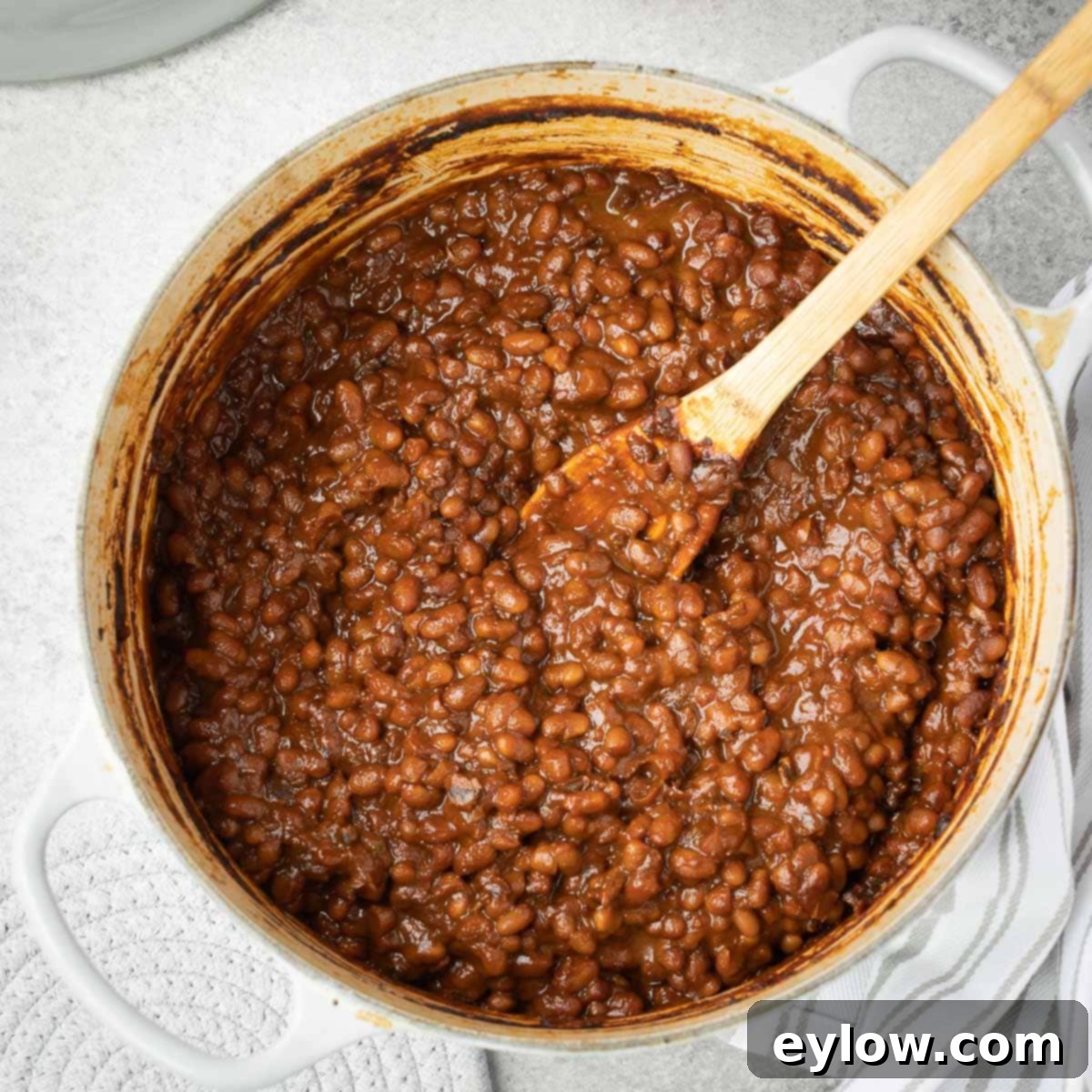Classic Boston Baked Beans from Scratch: Sweet, Savory, and Deeply Flavorful
If you’ve ever dreamed of making truly authentic Boston baked beans from scratch, you’re in for an unparalleled culinary experience. This isn’t just a side dish; it’s a slow-cooked masterpiece, brimming with sweet, savory, and wonderfully smoky flavors from rich molasses and savory bacon. A beloved American classic, these baked beans represent the epitome of comfort food, perfect for any gathering, from summer cookouts to cozy winter meals. While the process demands a little patience, most of the time is hands-off, allowing the deep, complex flavors to develop beautifully. The reward? The best homemade baked beans you’ve ever tasted. Start by soaking your beans the night before, and prepare for a truly memorable dish. For those moments when time is a luxury, we also provide a convenient shortcut using canned beans that still delivers exceptional, rich flavor without compromising on taste.
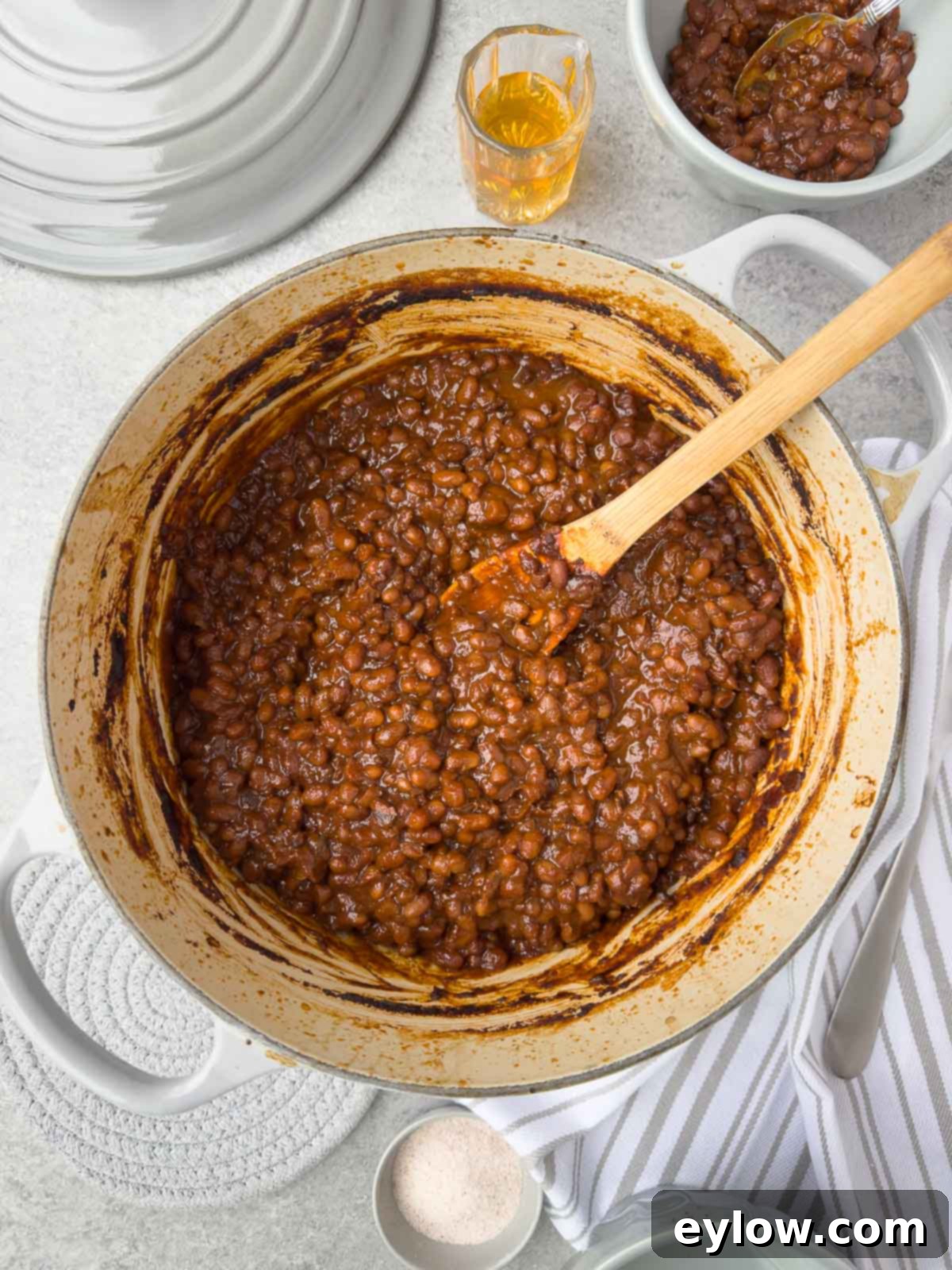
Embarking on the journey of making baked beans from dried beans takes more time than opting for canned varieties, but this process is thoughtfully spread across several stages: initial soaking, gentle simmering, and a final long, slow bake. The beauty of this method lies in its “hands-off” nature for much of the cooking, allowing you to go about your day while the magic happens. We firmly believe that the rich, unparalleled flavor and tender texture achieved through this scratch-made approach are absolutely worth the effort. Nothing compares to the deeply satisfying taste of homemade baked beans, crafted with care from the ground up.
[feast_advanced_jump_to]
Why You’ll Love This Authentic Boston Baked Beans Recipe
Our recipe for Boston baked beans is designed to bring you joy and deliciousness with every spoonful. Here’s why this classic dish will quickly become a favorite in your kitchen:
- A Timeless American Classic: These beans are an iconic side dish, deeply rooted in American culinary tradition. They are the quintessential accompaniment for summer cookouts, backyard barbecues, holiday feasts, or simply a comforting meal on a chilly evening.
- Effortlessly Adaptable for Vegetarians: Easily transform this rich dish into a hearty vegetarian or even vegan option by simply omitting the bacon. For a plant-based version, use a good quality olive oil to sauté the onions, ensuring a delicious and satisfying meatless meal.
- Clear, Step-by-Step Guidance: We’ve meticulously crafted easy-to-follow instructions that guide you through each stage of the cooking process, from soaking the beans to their final bake. Even if you’re a novice in the kitchen, you’ll feel confident creating this impressive dish.
- Quick & Convenient Canned Bean Shortcut: We understand that life can be busy. That’s why we’ve included a fantastic shortcut using canned beans that dramatically reduces prep time while still delivering a remarkably rich and flavorful result. You can enjoy homemade taste even on your busiest days.
If you’re looking for other quick and flavorful bean-based options, consider trying our easy three-bean salad with Dijon vinaigrette or this refreshing summer white bean salad. Both recipes utilize pantry-staple canned beans and can be whipped up in mere minutes, making them perfect for last-minute meals or potlucks.
Essential Ingredients for Boston Baked Beans
Crafting deeply flavorful Boston baked beans requires a thoughtful selection of ingredients. While this recipe takes a few liberties with tradition, such as using Dijon mustard and optional smoked paprika, these additions only enhance the incredible depth of flavor. Here’s a closer look at what you’ll need:
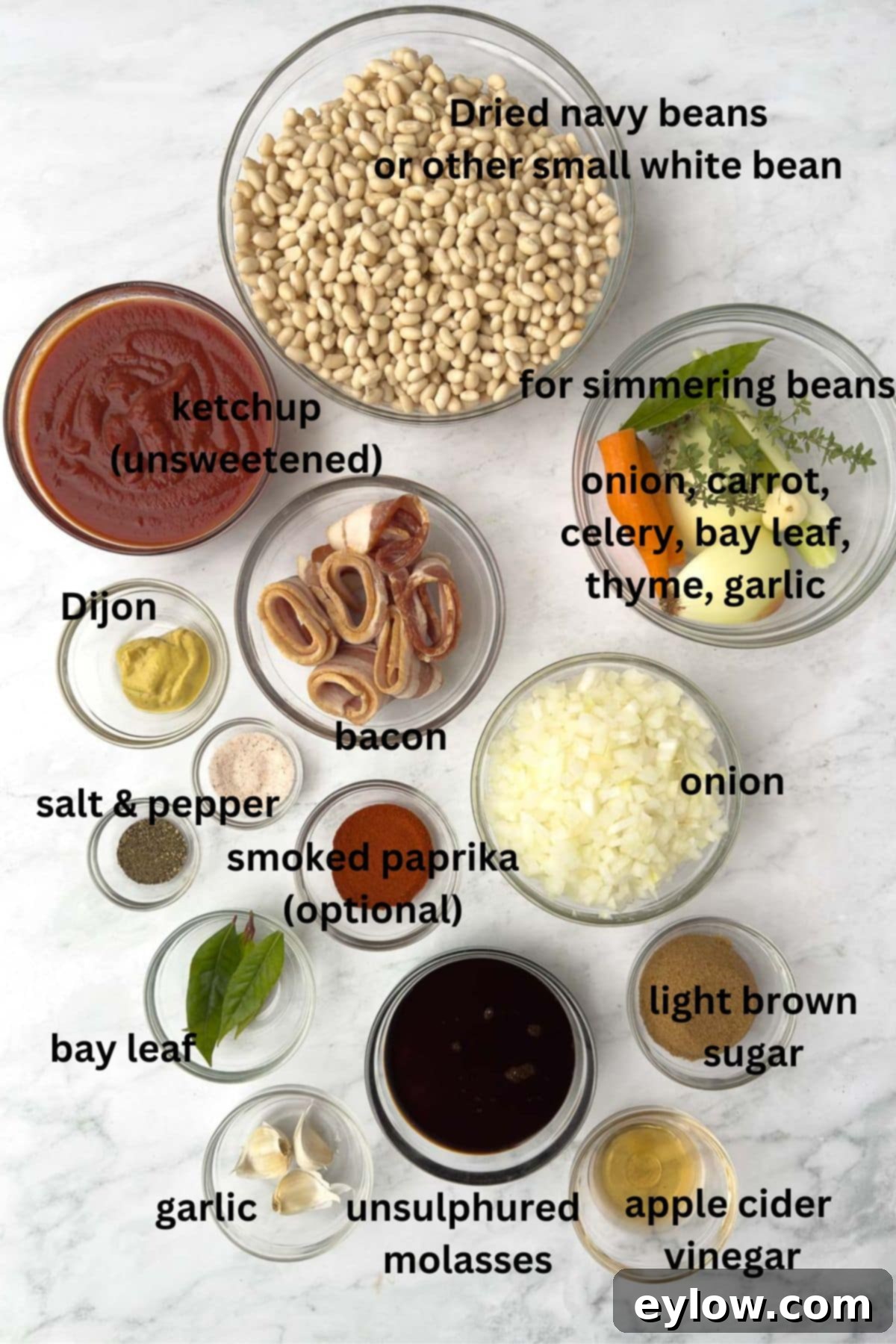
- Dried Beans: For the most authentic results, dried beans are highly recommended (unless you’re using our convenient shortcut). Navy beans are the traditional choice for Boston baked beans due to their small size, creamy texture, and ability to absorb flavors beautifully. However, you can also explore other options like Great Northern beans or cranberry beans, which also yield excellent results.
- Oil: A good quality olive oil is our preferred choice for sautéing the vegetables and building flavor. Avocado oil is another excellent neutral-flavored alternative if you prefer.
- Bacon: Thick-sliced bacon provides rich, smoky flavor and renders delicious fat that forms the foundation of our sauce. This is a flavorful alternative to traditional salt pork or a ham bone. For a vegetarian version, simply omit the bacon and use olive oil for sautéing.
- Onion: Yellow or brown onions are essential, adding natural sweetness, moisture, and a foundational aromatic depth to the beans. They caramelize beautifully during the cooking process.
- Garlic: This pungent, savory aromatic is crucial for enhancing the overall savory profile of the beans, complementing the sweetness of the molasses and balancing the richness of the bacon.
- Molasses: A non-negotiable ingredient for true Boston baked beans! Molasses, a byproduct of the sugar refining process, provides that characteristic deep, dark color and complex, slightly bitter-sweet flavor that defines this dish. We recommend unsulphured molasses, often labeled as blackstrap, for its robust flavor.
- Sugar: Light brown sugar adds additional sweetness and depth, complementing the molasses. For a reduced-sugar option, a golden monk fruit blend can be used as a substitute.
- Ketchup: Ketchup contributes tanginess, sweetness, and a lovely umami depth to the sauce. We prefer using unsweetened ketchup to better control the overall sugar content.
- Mustard: While dry ground mustard is traditional, Dijon mustard offers a more nuanced, sharper flavor that we find works exceptionally well. Its acidity also helps cut through the richness of the dish.
- Vinegar: Apple cider vinegar is key to balancing the sweetness of the molasses and brown sugar, adding a bright, acidic note that prevents the beans from being overly cloying.
- Paprika: Not strictly traditional, but smoked paprika is an optional ingredient that adds another layer of subtle smokiness and a beautiful reddish hue, enhancing the overall flavor profile.
- Bay Leaf: A bay leaf contributes a subtle, herbaceous depth and aromatic complexity to the simmering beans and the final baked dish, a classic addition to many slow-cooked recipes.
Additionally, for the simmering phase of the dried beans: To infuse your beans with even more foundational flavor, you’ll need a few extra aromatics. These include another half an onion, one celery rib, a carrot, a bay leaf, and a couple of fresh thyme sprigs (or sage/rosemary). While optional, these ingredients create a nuanced broth during the initial cooking, which significantly enhances the final taste of your baked beans. You’ll remove these vegetables before baking, but their essence remains.
Please refer to the recipe card below for precise measurements of all ingredients, including salt and black pepper.
Chef’s Note on Time: The Magic of Slow Baking
Ever wondered why Boston baked beans, even those starting with canned varieties, require hours in the oven? It’s not about achieving tenderness – the beans are already soft from soaking and simmering (or already cooked if canned). The true purpose of that long, slow baking time is to unleash a remarkable transformation: the development of a deep, complex flavor profile and that signature rich, glossy, sticky sauce. As the beans slowly bake, the sugars from the molasses and ketchup undergo a gentle caramelization, creating layers of sweet and savory notes. The acidity from the vinegar mellows beautifully, while the sauce gradually thickens to that iconic, irresistible consistency that simply cannot be achieved through stovetop cooking alone. If you have the time, this extended baking period is worth every single minute for the depth of flavor it imparts.
Substitutions and Flavor Variations
This Boston baked beans recipe is wonderfully versatile, allowing for various substitutions and additions to suit your taste preferences or dietary needs:
- Mustard Swap: If you prefer the traditional dry mustard, use 1 teaspoon of dry ground mustard in place of 1 tablespoon of Dijon mustard for a sharper, more classic profile.
- Dried Bean Alternatives: While navy beans are classic, feel free to substitute them with other small white beans such as Great Northern beans or even cranberry beans. For an adventurous twist, explore heirloom bean varieties like Marcella, Alubia Blanca, or Yellow Eye beans, which offer unique textures and flavors.
- Canned Bean Options (for Shortcut): When using the shortcut method, choose canned navy beans, Great Northern beans, or borlotti beans (the Italian name for cranberry beans). Ensure they are well-drained and rinsed before use.
- Vegetarian or Vegan Option: To make these Boston baked beans entirely meatless, simply omit the bacon. Instead, use a quality olive oil to sauté the onion and garlic, building a rich flavor base without animal products.
- Add Ginger: For an unexpected yet delightful twist, incorporate a touch of ginger. You can use jarred ginger puree for convenience, or finely grate fresh ginger root. Sauté it along with the onions to infuse the dish with a warm, spicy note.
- Transform into an Entrée: For a heartier meal, consider adding browned ground beef or ground turkey during the baking stage. Cooked and chopped chicken sausage is another excellent addition that can turn this side dish into a main course.
- A Dash of Balsamic: A splash of good quality balsamic vinegar can introduce a deeper, more complex sweetness and acidity, elevating the overall flavor. Add it along with the apple cider vinegar.
Chef’s Tip: The Benefits of Soaking Beans
Why soak beans? Soaking is a crucial step that offers multiple advantages. It thoroughly hydrates the dried beans, which helps to soften their thick outer skins and ensures they cook more evenly. This also significantly speeds up the overall cooking process. Furthermore, adding kosher salt to the soaking water (a technique known as brining) dramatically improves the flavor of the beans by seasoning them from the inside out, rather than just on the surface. Soaking and brining together also work wonders in minimizing split or burst beans, resulting in a more visually appealing and uniformly cooked dish. Most beans genuinely benefit from this preparatory step. For more detailed insights, this article provides a good reference.
Recipe Instructions for Homemade Boston Baked Beans
Start Here: Using Dried Beans
The journey to truly homemade baked beans begins with properly preparing your dried beans. This initial phase ensures a tender, flavorful foundation for the dish.
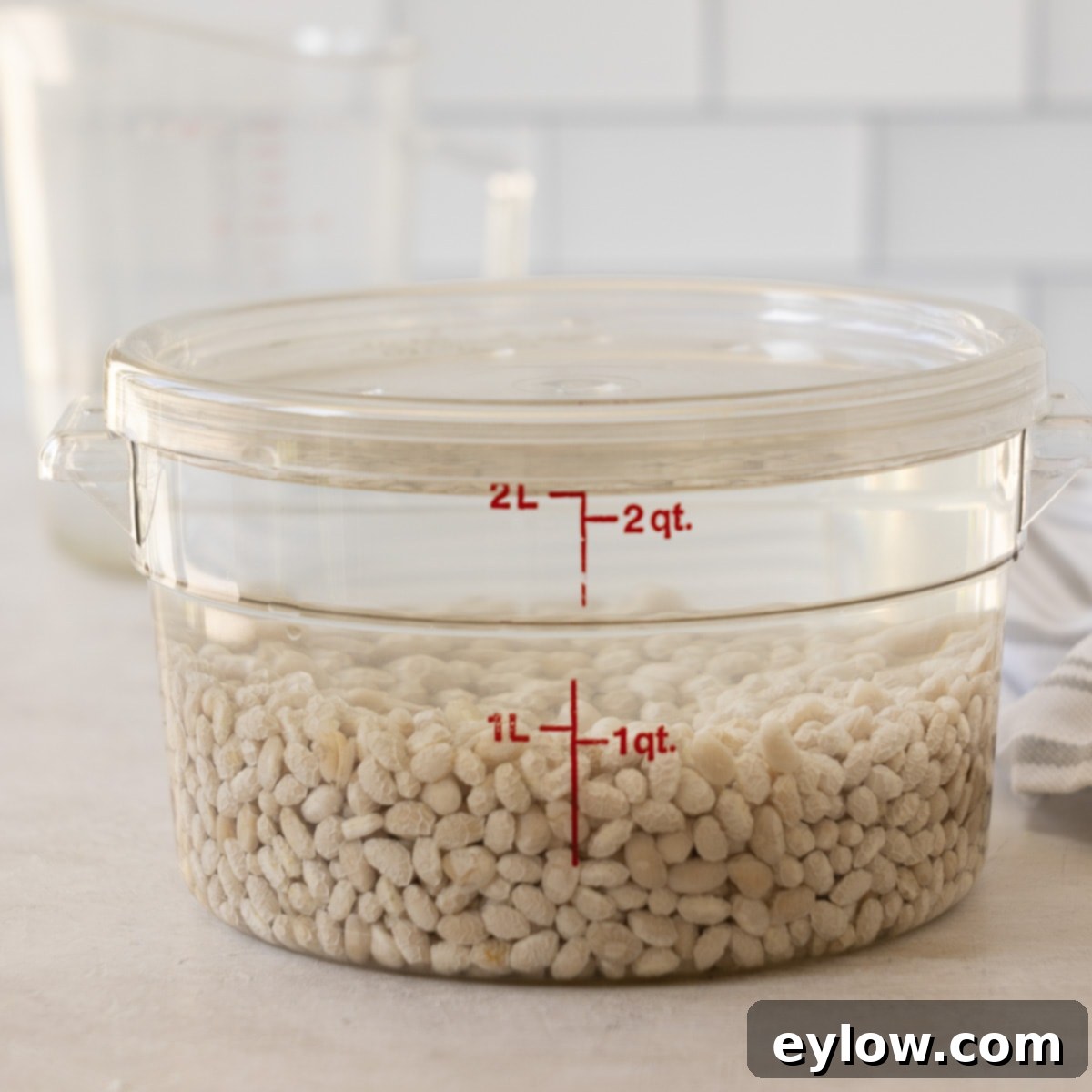
- Soak the Beans (Overnight): Begin by thoroughly rinsing your dried beans in cold water, meticulously picking out any broken pieces or debris. Transfer the cleaned beans to a large container and cover them generously with water, ensuring there’s at least double the volume of water to beans. Add 1 tablespoon of kosher salt per quart of water to brine them, which enhances flavor and texture. Cover the container and refrigerate for 12 hours, or overnight.
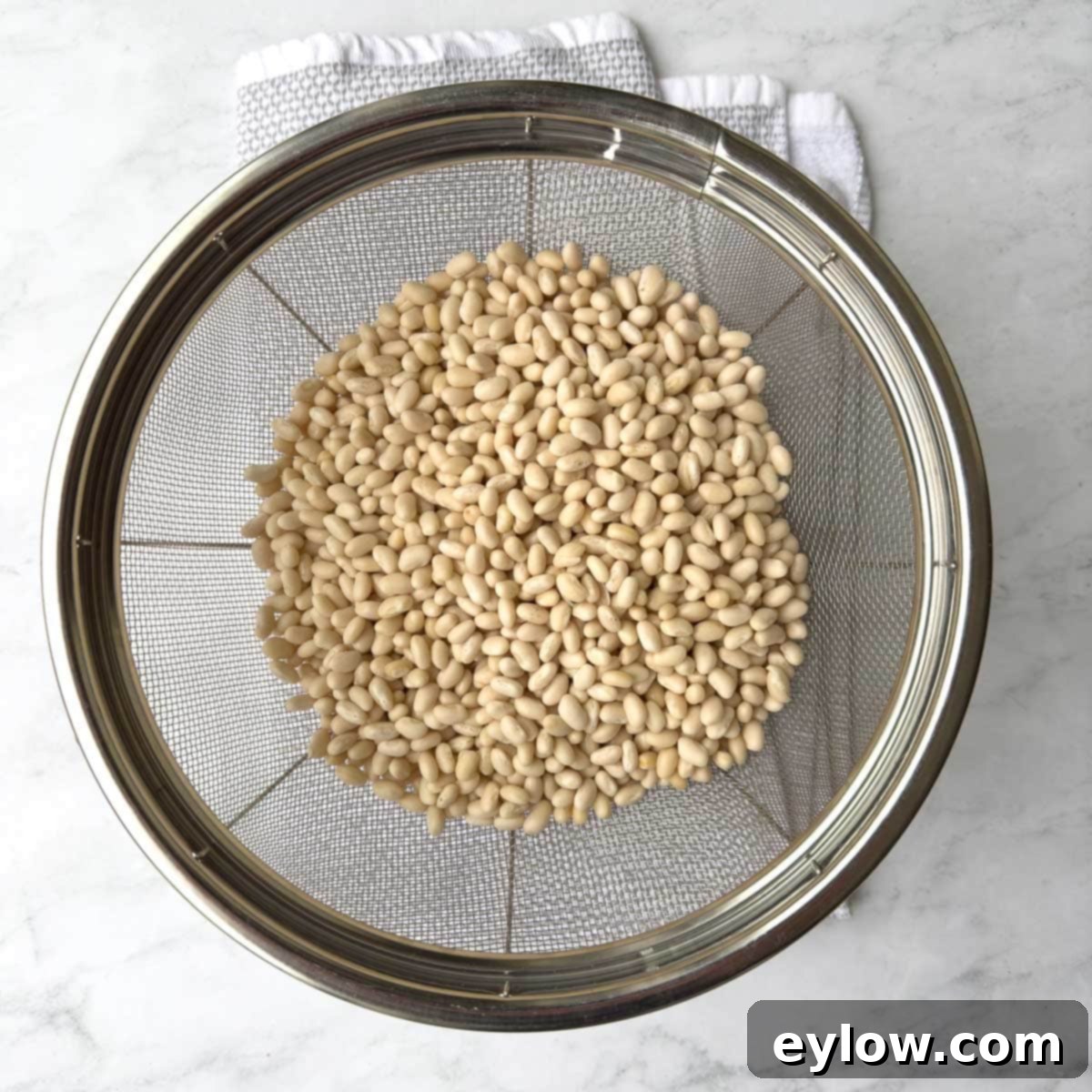
- Drain and Rinse: Once soaking is complete, drain the beans completely in a colander and rinse them thoroughly under cold running water. Discard the salty soaking water, as this helps with digestibility and ensures a fresh start for the simmering phase.
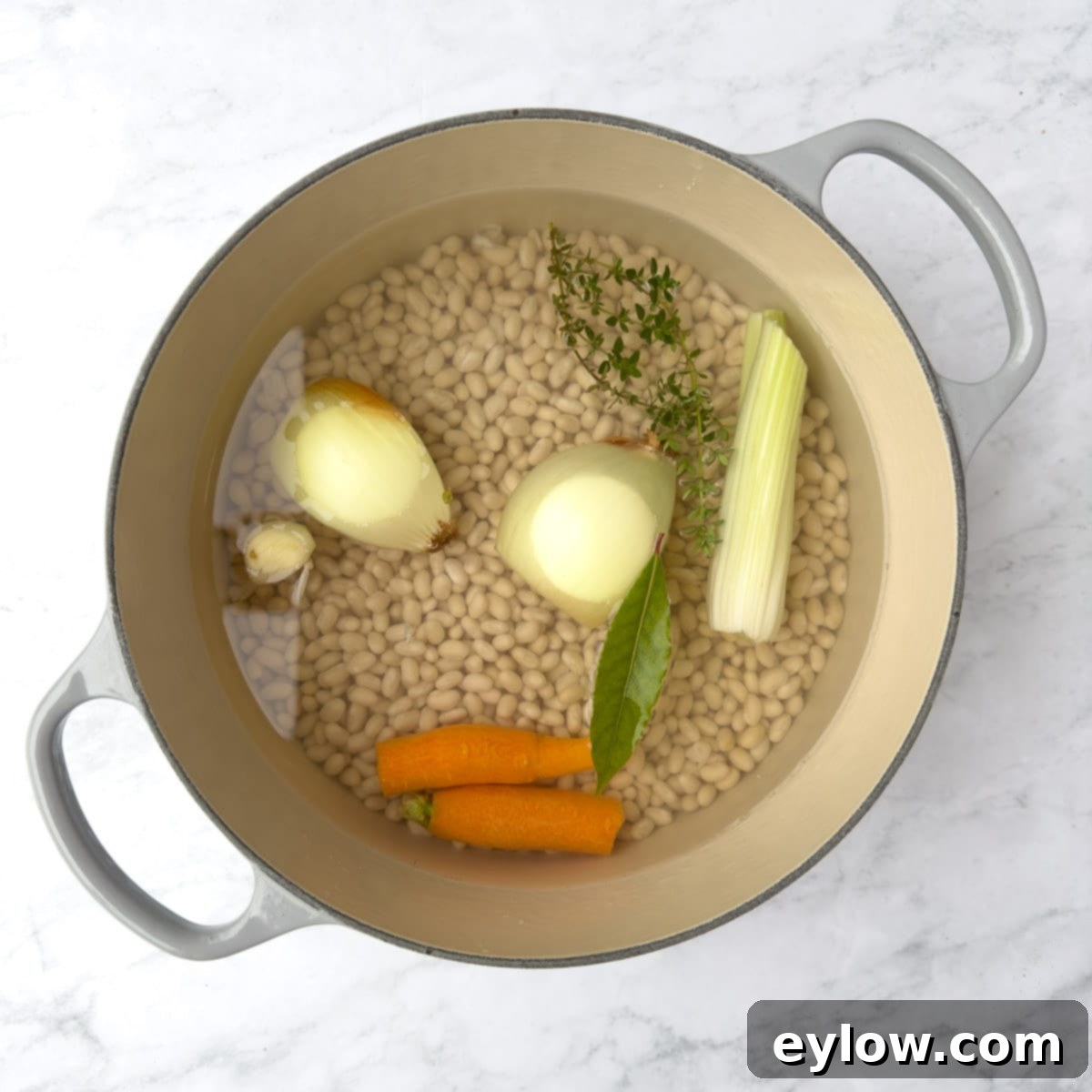
- Initial Boil and Simmer: Transfer the drained, soaked beans to a large, heavy-bottomed pot, such as a 5 ½-quart Dutch oven with a tight-fitting lid. Cover the beans with fresh water by several inches. Add the additional aromatics (half onion, carrot, celery rib, smashed garlic cloves, bay leaf, and thyme sprigs) to the pot for extra flavor during this stage. Bring the water to a rolling boil and continue to boil vigorously for 10 minutes, skimming off any foam that rises to the surface.
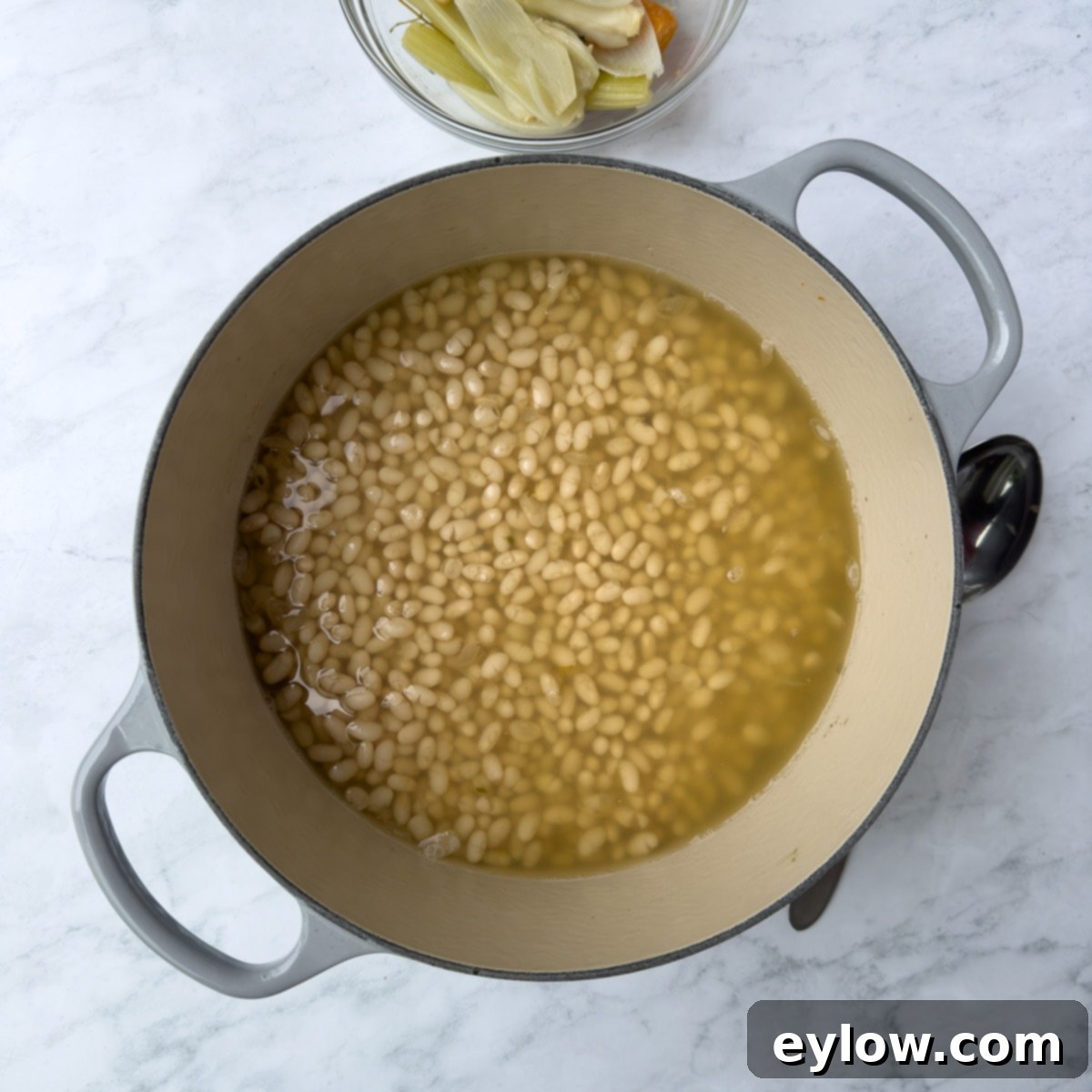
- Simmer Until Tender: Reduce the heat to low, cover the pot, and let the beans simmer gently until they are fully tender. This typically takes about 1 hour, though older beans might require a bit longer. Throughout this simmering period, check the water level occasionally and add hot water from a tea kettle as needed to keep the beans submerged. Once tender, carefully remove and discard the simmering vegetables and bay leaf. Drain the beans, making sure to save the flavorful cooking liquid (bean broth), as it will be used later in the baking process.
Start Here: If Using Canned Beans (Shortcut Method)
If you’re opting for the time-saving canned bean shortcut, begin here. The intense baking time will still develop the deep flavors you expect from Boston baked beans.
Note for Vegetarians/Vegans: To make this dish meatless, omit the bacon cooking steps. Instead, use 2 tablespoons of olive oil to sauté the onion and garlic, building your flavor base before adding the sauce ingredients.
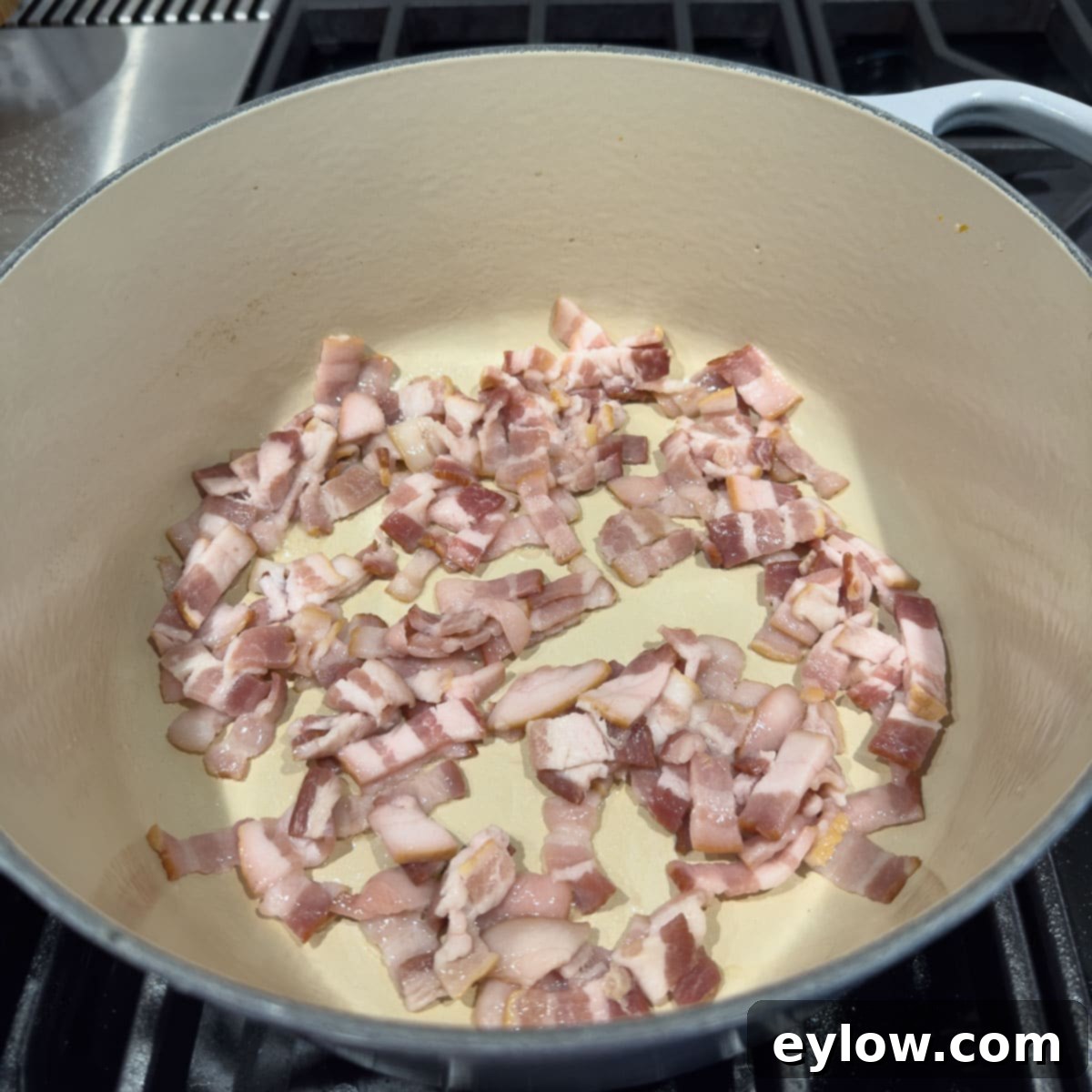
Step 1: Cook the Bacon. Chop the thick-cut bacon crosswise into small pieces, about ½-inch wide strips. Add the bacon to the same large, heavy pot (like your Dutch oven) used for simmering the beans, or a clean pot if starting fresh with canned beans. Turn the heat to medium-low and cook the bacon slowly.

Step 2: Reserve Bacon and Fat. Continue cooking the bacon until it’s wonderfully crisp and golden brown. Once cooked, use a slotted spoon to remove the bacon pieces from the pot and transfer them to a plate lined with paper towels to drain. Carefully pour off most of the rendered bacon fat, reserving about 2 tablespoons of this flavorful fat in the pot. This fat will be the base for sautéing your aromatics.
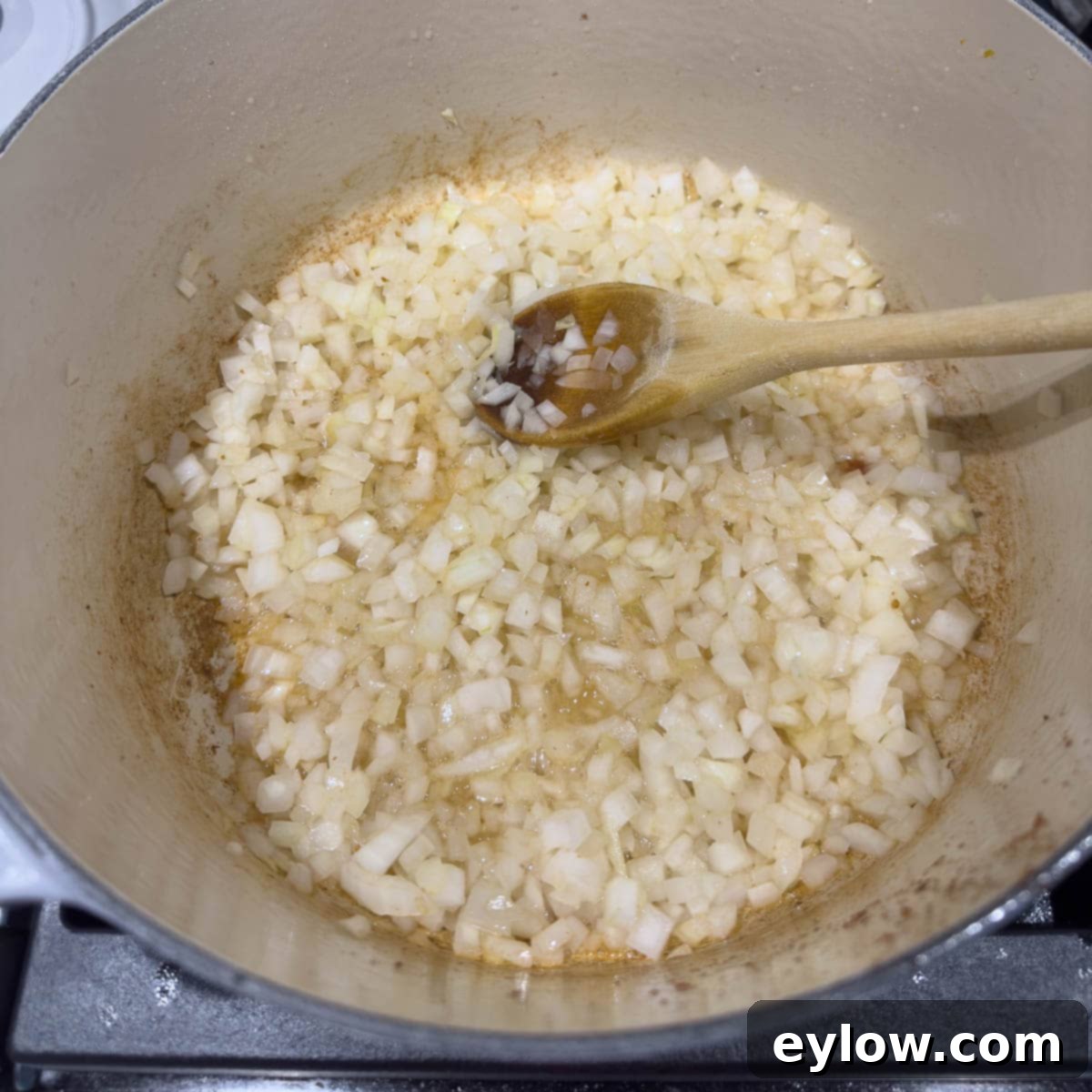
Step 3: Sauté Aromatics. Add the chopped onion to the 2 tablespoons of reserved bacon fat in the pot. Cook the onion over medium-low heat, stirring occasionally, until it becomes soft, translucent, and lightly golden brown, about 8-10 minutes. Then, add the finely chopped garlic and cook for another minute until fragrant, being careful not to burn it.

Step 4: Incorporate Seasonings. Stir in the paprika (if using), light brown sugar, apple cider vinegar, sea salt, and ground black pepper into the softened onions and garlic. Continue stirring until the brown sugar has completely melted and the mixture is well combined. The vinegar will deglaze the pan slightly and balance the sweetness.

Step 5: Build the Sauce. Pour in the unsulphured molasses, unsweetened ketchup, and Dijon mustard into the pot. Stir thoroughly until all the ingredients are smoothly combined, creating a rich, dark, and aromatic sauce. This is where the signature flavor of Boston baked beans truly comes alive.
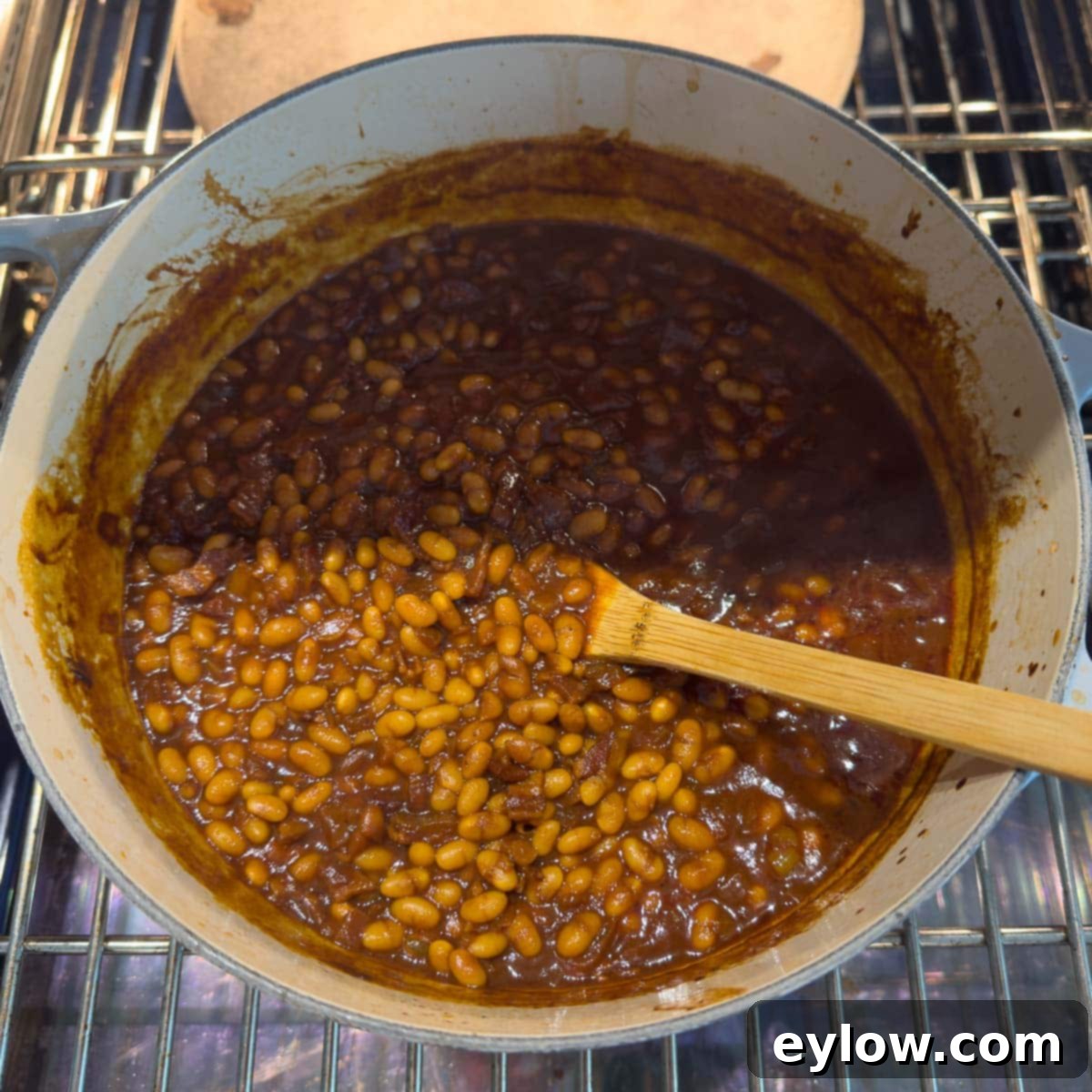
Step 6: Combine and Bake. Gently fold in your pre-cooked (or drained and rinsed canned) beans into the rich sauce, ensuring they are thoroughly coated. Stir in the reserved crispy bacon and add the bay leaf to the pot. Cover the pot with its lid and transfer it to your preheated 325°F (160°C) oven. Bake the beans for approximately 3 hours to allow the flavors to meld and deepen.

Step 7: Maintain Moisture. During the baking process, the sauce will thicken and reduce. Every hour, gently stir the beans and check their consistency. If the liquid level appears low or the beans are getting too thick, stir in a little of the reserved bean broth (or hot water if you used canned beans). You want the beans to remain moist and saucy, not dry, ensuring a creamy texture and preventing scorching.
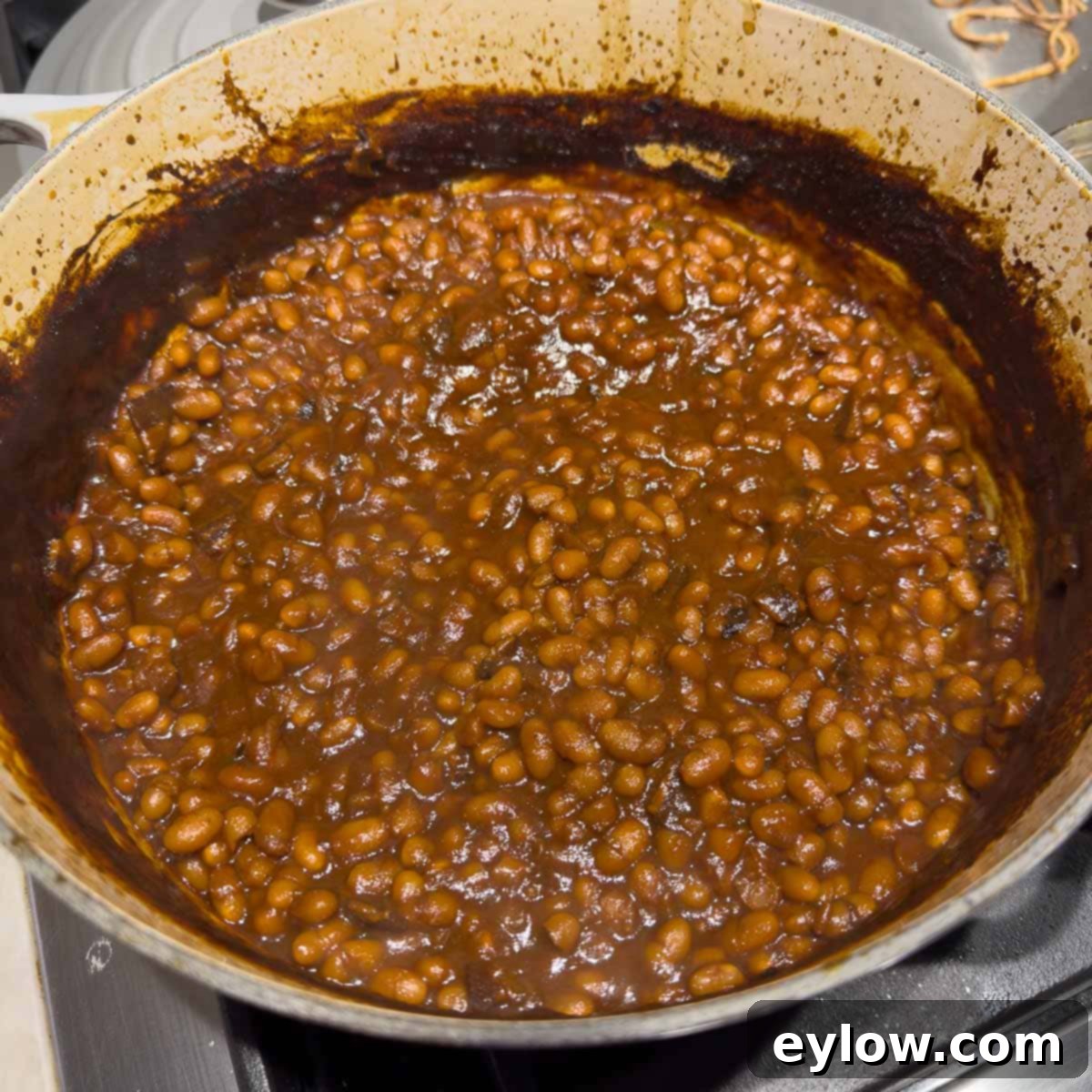
Step 8: Final Check and Reserve. After approximately 2.5 to 3 hours, test the beans for doneness. They should be incredibly tender, creamy, and coated in a rich, glossy sauce. If they’re not quite there, continue baking for another 30 minutes, checking moisture levels. Once done, save any extra bean broth and refrigerate it. This flavorful broth will be invaluable for reheating leftovers, allowing you to easily restore the beans to their perfect, juicy consistency.
Chef’s Tip: Discarding Soaking Water – A Digestive Debate
There’s often conflicting advice regarding whether to discard or save the bean soaking water. Some culinary experts suggest retaining it, citing its nutrient content and starches that can contribute to a richer broth. However, many others, including us, advocate for discarding the soaking water and cooking with fresh water. This approach is primarily recommended to improve digestibility by removing indigestible sugars that can cause gas. It’s an absolute must to discard the soaking water if you added salt to it for brining, as the water would be too salty for cooking.
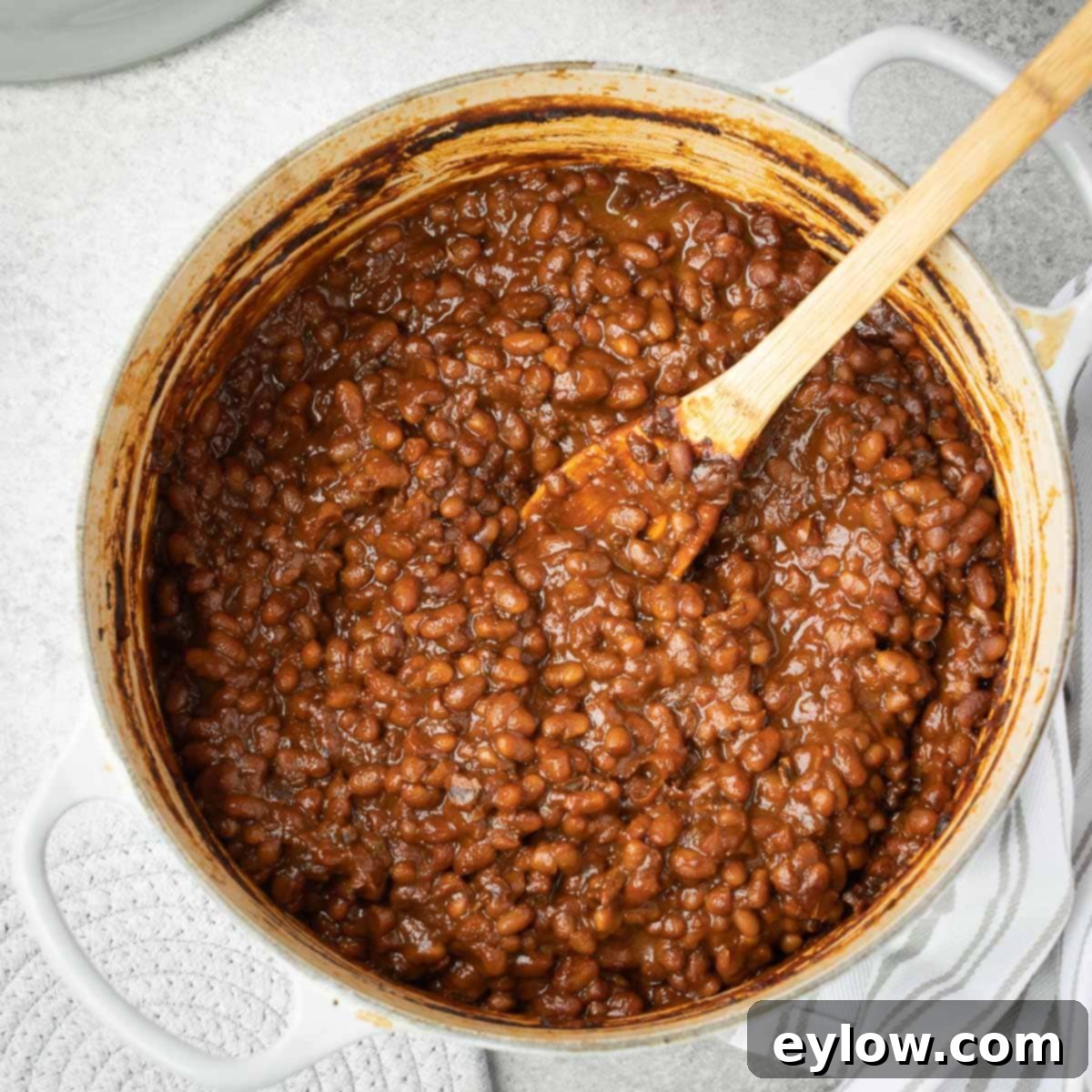
How to Quick Soak Dried Beans
If you find yourself short on time or simply forgot to soak your dried beans overnight, the quick soak method is a fantastic alternative. It prepares your beans for cooking in a fraction of the time, so you can still enjoy delicious homemade baked beans without the long wait. Here’s how to do it:
- Rinse and Sort: Start by rinsing the dried beans thoroughly under cold running water in a colander. Carefully inspect the beans and discard any broken pieces or foreign debris.
- Boil and Steep: Place the rinsed beans in a large, heavy-bottomed pot, such as a Dutch Oven. Cover them generously with fresh water, ensuring the water level is several inches above the beans. Add a tablespoon of salt to the water (optional, but recommended for flavor). Bring the water to a rolling boil and let the beans cook for 2 minutes.
- Rest: After 2 minutes, remove the pot from the heat, cover it with a tight-fitting lid, and let the beans stand on the stove for 1 hour. This steeping period allows the beans to rehydrate and soften effectively.
- Drain and Proceed: Once the hour is up, drain the beans completely and rinse them well under cold water. They are now ready to proceed with the simmering and baking stages of your Boston baked beans recipe.
Chef’s Note: Accelerated Soaking & Simmering with a Pressure Cooker or Instant Pot
For even greater time savings on the soaking and simmering steps, consider using a pressure cooker or an Instant Pot. You can start with un-soaked dried beans directly in the appliance. Refer to a reliable time table for pressure cooking dried beans to achieve tender results. Once the beans are cooked to tenderness in the pressure cooker, you can then drain them (reserving liquid), and continue directly with cooking the bacon and assembling the sauce for the final baking phase in the oven. This significantly cuts down on the overall hands-on and passive cooking time.
Delicious Serving Suggestions for Boston Baked Beans
Boston baked beans are incredibly versatile and pair wonderfully with a variety of main dishes. What do you typically serve with baked beans? They are the quintessential side dish for classic American barbecue fare, perfect alongside juicy burgers, sizzling hot dogs, or especially tender baby back ribs glazed with homemade sauce. Here are a few additional side dish ideas to complete your summer barbecue menu or any comforting meal:
- Mediterranean Potato Salad: A lighter, herb-filled potato salad offers a refreshing contrast to the richness of the beans.
- Fresh Homemade Coleslaw: A crisp, vibrant coleslaw with a light dressing provides a crunchy, tangy counterpoint.
- Summer Green Bean Salad with Corn and Tomatoes: This colorful salad brings freshness and a sweet-savory balance.
- A Big Green Salad: A simple, crisp green salad with a vinaigrette is always a welcome addition to balance a hearty meal.
- Corn on the Cob: Sweet, buttery corn on the cob is a classic partner, especially during summer months.
- Crusty Bread or Cornbread: Don’t forget something to soak up all that delicious, rich sauce!
If you find your Boston baked beans a tad too sweet for your preference, a little extra splash of apple cider vinegar can help brighten and balance the flavor. Conversely, if you desire a touch more sweetness, a drizzle of genuine New England maple syrup makes a lovely addition. Its distinct flavor profile wonderfully complements the existing molasses and brown sugar in the recipe, adding another layer of complexity. Adjust to your taste, and enjoy!

Make-Ahead, Reheating, and Freezing Tips
Boston baked beans are a fantastic dish to make ahead, making them perfect for entertaining or meal prepping. They often taste even better the next day as the flavors have more time to meld and deepen. Here’s how to handle leftovers and make the most of your delicious batch:
Making Ahead: If you plan to prepare the beans a day or two in advance, allow them to cool completely (to a minimum of 70°F) before transferring them to an airtight container. Refrigerate promptly, where they will keep for up to 4 days. Note that the beans will firm up considerably when cold, so they will need some additional liquid when reheating to regain their creamy, saucy texture.
Reheating a Whole Pot (Oven Method): For a large batch, stir in a little of the reserved bean broth or water if you want them juicier. Cover the pot and heat in a 325°F (160°C) oven for approximately 1 hour, or until the beans reach an internal temperature of at least 165°F (74°C) when measured with a digital thermometer. This method works beautifully for evenly reheating a full pot.
Reheating Portions (Stovetop Method): For smaller quantities, transfer the desired amount to a saucepan. Add a splash of reserved bean broth or water to achieve your desired consistency. Cover the pan and heat over low heat, stirring occasionally to prevent sticking and scorching on the bottom, until the beans are thoroughly hot.
Reheating Portions (Microwave Method): Individual portions can also be conveniently reheated in the microwave. Place the beans in a microwave-safe bowl, add a little liquid, cover loosely, and heat on 70% power in 1-2 minute increments, stirring between intervals, until heated through.
Freezing Homemade Baked Beans
Given the effort involved in making a batch of these delectable beans from scratch, we highly recommend considering making the full recipe and freezing the leftovers. Baked beans freeze exceptionally well for up to 3 months, making them a perfect solution for quick, comforting side dishes on busy weeknights. Portions can be frozen in individual containers, or even better, in specialized freezing trays like Souper Cubes, which create perfect serving sizes. Simply thaw overnight in the refrigerator and reheat using one of the methods above, adding a touch of liquid as needed.
Recipe FAQs: Your Boston Baked Beans Questions Answered
The defining characteristic that sets Boston baked beans apart is the prominent use of molasses. According to historical culinary accounts, molasses, a thick, dark brown syrup produced during the sugar refining process, imparts a distinctive rich, sweet, and slightly smoky depth of flavor, along with a gorgeous, dark, glossy color. This ingredient is so fundamental that brown sugar itself gets its color and some flavor from molasses. While many baked bean recipes use brown sugar, the higher concentration of molasses in Boston-style beans creates their unique, unmistakable taste and deep hue.
Traditionally, the small, creamy navy bean is the star of Boston baked beans. Its delicate skin and starchy interior make it ideal for absorbing the rich molasses-based sauce and achieving that signature tender, almost melt-in-your-mouth texture. However, other small white beans can make excellent substitutes. Great Northern beans are a particularly good swap, offering a similar texture and flavor profile. Pinto beans and cranberry beans (also known as borlotti beans) also work beautifully, adding a slightly different earthy note while still holding up well to the long cooking time.
If your beans remain stubbornly hard despite extended cooking, several factors could be at play. The most common culprit is old beans; dried beans, especially if improperly stored for a long time, can become extremely hard and resistant to softening. If you suspect your beans are old, try this softening trick: add ¼ teaspoon of baking soda to the soaking water (but be cautious, too much can lead to mushy beans). Another significant factor can be the water itself. Hard water, rich in minerals like calcium and magnesium, can prevent beans from fully softening. Using filtered water instead of tap water can often resolve this issue. Similarly, highly chlorinated water can also contribute to tough beans, so filtered water is again the recommended solution for consistently tender results.
More Terrific Side Dish Recipes and Culinary Inspiration
Looking for more inspiring ideas for your summer menus or delicious side dishes throughout the year? Our collection offers a variety of recipes perfect for grilling, potlucks, and everyday meals. For even more culinary exploration, browse our extensive side dishes category. And for a versatile sauce that’s great for grilling, dipping, or stir-fries, don’t miss our homemade hoisin sauce, which is also gluten-free!
- Crunchy Broccoli Salad with Bacon
- Avocado Corn and Black Bean Salad
- Simple Easy Coleslaw Recipe
- Lemony Mediterranean Pasta Salad Recipe
⭐️Did You Make This Recipe?
If you embark on the delightful journey of making Boston Baked Beans from Scratch, we’d absolutely love to hear about your experience! Please take a moment to add your comment below. Your feedback is incredibly valuable to us, and we truly enjoy hearing from you. If you loved this recipe and found it a sweet, savory success, please consider giving it a 5-star rating! Your ratings and reviews genuinely help other readers discover and enjoy this classic dish.
📖 Recipe
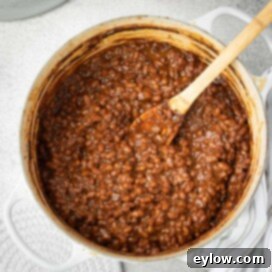
Boston Baked Beans from Scratch
Sally Cameron
Pin Recipe
Equipment
-
Large heavy pot or large Dutch oven 5 ½ quarts with lid
-
Colander
Ingredients
Basic bean soaking
- 1 pound dried small white beans such as navy beans see notes below on bean options, for shortcut use 4-15 ounces cans of beans.
- 1 ½-2 quarts filtered water enough to cover the beans by 4 inches for soaking
- 1-2 tablespoons kosher salt for brining 1 tablespoon per quart of water
Bean pre-cooking (aromatics)
- ½ onion yellow or brown
- 1 carrot peeled and cut in half crosswise
-
1 rib celery cut in half crosswise
- 2 garlic cloves peeled and smashed
- 1 bay leaf
- 2 fresh thyme sprigs sub sage leaves or rosemary
Baked beans
- 6 ounces thick cut bacon chopped crosswise into strips
- 1 ½ cups chopped onion, yellow or brown 1 large onion
- 2-3 garlic cloves finely chopped
- ⅓ cup light brown sugar or golden monk fruit blend
- 1 tablespoon apple cider vinegar
- 2 teaspoons regular or smoked paprika optional
- 1 ½ teaspoons sea salt
- ½ teaspoon ground black pepper
- ½ cup unsulphured blackstrap molasses
- 1 ½ cups unsweetened ketchup
- 1 tablespoon Dijon mustard sub 1 teaspoon dry mustard
- 1 bay leaf
Instructions
Soak the beans (the night ahead)
-
Place dry beans in a colander, rinse well with cold water and remove any broken beans. Place beans in a large container and cover with double the amount of cold water. Add 1 tablespoon of kosher salt per quart of water (brining). Cover beans and refrigerate 12 hours or overnight. Before cooking, drain beans and rinse well. Discard soaking water. To quick soak, see notes below.
Pre-cook the beans
-
In a large heavy pot such as a 5 ½ quart Dutch Oven, add the soaked, drained beans and enough fresh filtered water to cover by several inches. Bring to a boil, boil 10 minutes, skimming any foam that develops. Turn the heat down to medium-low, add the aromatics and simmer until tender, approximately 1 hour.
Check the beans occasionally to make sure they are covered with water. As needed, add hot filtered water from a tea kettle. When beans are tender, drain the beans, saving the bean broth, and continue with the recipe.
Start the beans
-
Pre-heat the oven to 325°F degrees. Fry the chopped bacon in the same pot until crisp and browned. Remove bacon to paper towels reserving the bacon fat. Add 2 tablespoons bacon fat back to the pan and cook the onion until soft and lightly golden, 8-10 minutes, over medium-low heat. Add garlic and cook another minute.
-
Add the brown sugar, vinegar, salt, pepper and paprika and stir until sugar is melted. Stir in the molasses, then the ketchup and mustard until smooth.
Gently fold in the beans until coated. Add the bay leaf and bacon. Top the pot with the lid.
Bake the beans
-
Bake for 3 hours, checking each hour and adding a little of the reserved bean broth or water if needed. At 2 ½ hours test beans for doneness. If they are not totally tender, bake for another 30 minutes. When beans are done, save and refrigerate 2 cups of extra bean broth for re-heating, to make the beans juicier if needed.
Serving and Storing
-
Serve baked beans hot or warm and re-heat well if you have leftovers, and will keep up to 4 days in the refrigerator. Extra freezes well in an airtight container for up to 3 months.
Notes
To quick soak beans, rinse dried beans with cold water in a colander and check for any broken beans or debris. Place beans in a large heavy pot such as a Dutch Oven and cover with fresh water by several inches. Bring beans to a boil and cook for 1-2 minutes. Turn off heat, cover the beans and let stand on the stove for 1 hour. Drain and proceed with the recipe.
Canned beans shortcut:
To save time, swap the dried beans for 4 -15-ounce cans of beans, drained and rinsed. Use navy beans, great northern, or borlotti. Add them to the pot at the step where the cooked beans go in the full recipe. Bake uncovered at 325°F for about 1 hour, stirring occasionally. Check for consistency and flavor—add a splash of liquid if they look dry, or bake a little longer to thicken if needed.
Yield Note:
This recipe makes a generous batch—about 9 to 10 servings—using 1 pound of dried beans. It’s perfect for parties, BBQs, or meal prep. You can easily cut the recipe in half if you’re cooking for a smaller group.
Freezer Tip:
If you’re going to the effort, consider making the full batch and freezing leftovers in individual portions. Baked beans freeze beautifully for up to 3 months and reheat well for quick sides on busy nights.
